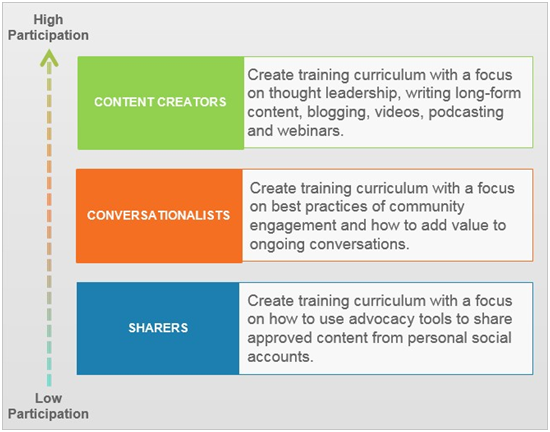W2O Group 27 May 2016 // 5:02PM GMT

A lot of my recent work revolves around helping clients get employee advocacy efforts off the ground. Brands are thinking about activating employees and for good reason. They understand that potential customers trust information from employees they know personally more than when it comes from executives or from the brand itself. But brands that focus on pushing content are missing the best part: developing and empowering the internal subject matter experts (SMEs).
Enlisting employee advocates to share content is a good first step. No question that it helps drive awareness and attention to content that brands produce. But in my experience, the real benefits happen when brands take the time to identify their own internal SMEs and empower them to connect to topic influencers outside the company. In other words, while all employee advocates are valuable, not all are created equal. No question sharers make up the biggest base of employee advocates. But, there is value in moving employee advocates up the hierarchy.

Here are Rules of Engagement I had worked to establish when Dell started doing social outreach back in 2007. Though I made some tweaks over the years, these have remained largely intact. One unlisted rule is to go where the conversations are happening.
So, what does it take to formalize a process? Both brands and employees have a part to play.
The Brand’s Role:
- Identify strategic topics
- Identify internal subject matter experts
- Identify the external topic influencers and build ways for your SMEs to follow
- Develop training that empowers your SMEs to connect with those topic influencers (RSS feeds, Twitter Lists)
The Subject Matter Expert’s Role:
- Check with your social team to understand your company’s social media policy (there may be some training or compliance classes you need to take)
- Follow the topic influencers you already know and those identified by your company
- Read their content on a regular basis
- Share their content (add your own context and make sure you give them credit when you do)
- Add value to conversations via replies on Twitter, comment on their blog, Facebook or LinkedIn groups – wherever the conversation is happening.
I know it is easy to say “add value to conversations.” But what does that really mean? For me, it’s about adding valuable context. Doing it right means you will share knowledge you have in a way that’s helpful to the conversation. It’s about digging deeper into a topic.
To illustrate context, here are three NPR stories:
- Preview of the Boston Marathon: This was a preview story that ran a week before the Boston Marathon in 2014, a year after the terrorist attack. Rather than just reporting another story about additional security precautions, they brought it to life by profiling a runner named Carol Downing and her daughter Erika Brannock. Erika was near the finish line to watch her mother finish the race. When bombs exploded, Erika was severely injured in the attack. Doctors had to amputate her right leg above the knee. Erika’s still working to recover. But she attended the Boston Marathon a year later to cheer her mom on again.
- Productivity, Technology and UPS: This makes a mundane topic of workplace productivity a lot more interesting for a geek like me. UPS trucks are loaded with sensors that measure up-to-the-second data for the smallest details. It collects that data in a black box at the back of the truck and sends it to Paramus, New Jersey for analysis. According to Jack Levis, the person responsible for making sense of the data, saving one minute per driver per day saves the company over $14.5 million over the course of the year. All these efficiencies have increase the average number of deliveries a driver can make from 90 to about 120 per day
- Lab Girl – Hope Jahren: This is a story about Hope’s new book called Lab Girl. Hope Jahren defines a leaf as a “platter of pigments strung with a vascular lace.” She also touched upon the challenges she’s faced as a woman on science. What I liked most about Hope is her ability to communicate scientific terms in terms a non-scientist would understand. Though she’s in a completely different field, Hope reminded me of the work that Danah Boyd and Michael Wesch do. This story is the reason I currently follow Hope on Twitter and have I told others to do the same.
I’m not saying you need to write a blog post for every conversation, but do not be afraid to go deep in a topic you’re an expert on. In a conversation, it may mean several comments in a dialog. The key is to pull in insights from your experience, third party research or articles from others to in an effort to educate and serve folks who are part of the conversation. It may mean you spend more time doing research. That’s a good thing. If you do it right, you will be adding value. Adding value to conversations is the key to becoming an influencer in your area of expertise. Do it consistently, and people will notice.
By: Lionel Menchaca


































.jpg)














